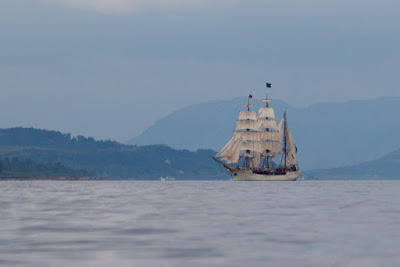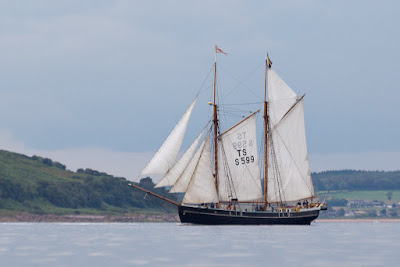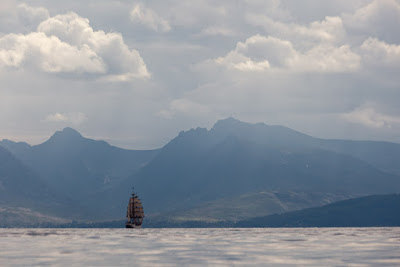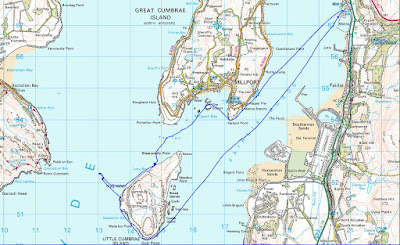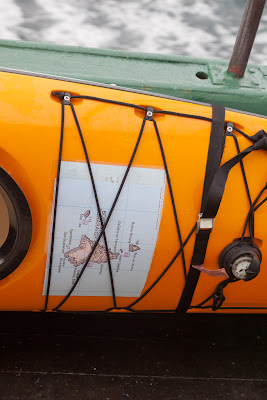No sooner had we finished our freshly caught fish suppers than the explanation of the VHF radio chatter was apparent. a procession of tall ships was making its way down the Clyde. The leader was Mir, St Petersburg, Russia. She is a 108.8m long square rigged ship and was built in Poland in 1987.
We paddled out to the edge of the shipping channel.
PS Waverley, Glasgow, Scotland appeared, followed by...
...a procession of the most beautiful ships. This is Sorlsandet, Kristiansand, Norway. She is a 64.2m long square rigged ship and was built in 1927.
The Waverley was built in Glasgow in 1947 in the Inglis Yard, which is now the site of Glasgow's new transport museum.
The Waverley now turned round to head back up the Clyde.
Europa, The Hague, Netherlands. She is a 54.6m long 3 masted barque built in 1911.
Constantia, Stockholm, Sweden. She is a 31.45m long 2 masted gaff schooner built in 1908.
Europa and Pelican.
Pelican and Europa.
Pelican of London, Weymouth, London, UK. She is a 44.42m long 3 masted barquentine built in 1948. However her rig is a very modern, designed to go to windward much better than a fully square rigged ship.
Europa.
Europa was one of the few to turn right towards the Kilbrannan Sound on the west coast of Arran.
the ex RNLI lifeboat Grace Patterson Ritchie (70-002) is now privately owned and based at Largs. She was built by Yarrows on the Clyde in 1966. She was the first of three Clyde class lifeboats and the first steel hulled RNLI lifeboat.
MV Llanreath is a converted Milfordhaven pilot vessel/tug. She is privately owned and based in Girvan.
Gloria, Cartagena, Colombia. She is a 65.61m long 3 masted barque built in Bilbao in 1968.
Gloria.
Gloria.
Irene, Bridgewater, UK. She is a 35.45m long gaff ketch built in Bridgewater in 1907.
Irene.
Pogoria, Gdynia, Poland. She is ia 49.52m 3 masted barquentine built in 1980.
Pogoria.
Pogoria.
Eventually we decided to land on the Little Cumbrae again but had to paddle past the resident pod of porpoises.
It was time for a well deserved third luncheon...
...then home for tea. All this within an hour's drive of home!
The full list of tall ships in the 2011 tall ships race can be found here.
Imagine you are at the edge of the sea on a day when it is difficult to say where the land ends and the sea begins and where the sea ends and the sky begins. Sea kayaking lets you explore these and your own boundaries and broadens your horizons. Sea kayaking is the new mountaineering.
Saturday, July 16, 2011
Friday, July 15, 2011
Fish and ships, part one.
Tuesday was a lovely day so Tony and I set off from Largs Marina...
...past the marine research station on Great Cumbrae island...
...and round Farland Point...
...where we passed this group of female eider ducks.
We entered the Tan between the Cumbraes and...
...landed on the Eileans for first luncheon.
We then set off for the Little Cumbrae Island trolling our fishing lines.
With the mountains of Arran in the distance, Phil caught us, he had been working all morning and had had no lunch!
We had noticed an unusual amount of VHF radio traffic. Then the MS Europa steamed majestically down the Clyde.
Fortunately for Phil, Tony caught three mackerel and I caught one, guess which one was mine!
We landed on the Little Cumbrae to cook them straight away. They didn't even have time to develop rigor mortis!
They were absolutely delicious! Then channel 16 on the VHF radios really started to buzz....
...past the marine research station on Great Cumbrae island...
...and round Farland Point...
...where we passed this group of female eider ducks.
We entered the Tan between the Cumbraes and...
...landed on the Eileans for first luncheon.
We then set off for the Little Cumbrae Island trolling our fishing lines.
With the mountains of Arran in the distance, Phil caught us, he had been working all morning and had had no lunch!
We had noticed an unusual amount of VHF radio traffic. Then the MS Europa steamed majestically down the Clyde.
Fortunately for Phil, Tony caught three mackerel and I caught one, guess which one was mine!
We landed on the Little Cumbrae to cook them straight away. They didn't even have time to develop rigor mortis!
They were absolutely delicious! Then channel 16 on the VHF radios really started to buzz....
Thursday, July 14, 2011
Farewell to St Kilda
Once the kayaks were secured on the Cuma's deck at 1730, Murdani wasted no time in setting off on the return journey to Loch Reasort, which divides Lewis and Harris. First Boreray and Stac an Armin then...
...the entire St Kilda archipelago slipped away over the western horizon. We were sorry our adventure had come to an end and spent the long return voyage chatting and reliving our experiences.
At 2240 we passed to the north of Scarp and to the south of Mealasta island on our way to the entrance to Loch Reasort.
The midsummer sun was well set by the time we dropped anchor in Loch Reasort. Then Murdani, Gary and Louise prepared our evening meal. A long day for them meant we had enjoyed a very full day! We slept well that night.
...the entire St Kilda archipelago slipped away over the western horizon. We were sorry our adventure had come to an end and spent the long return voyage chatting and reliving our experiences.
At 2240 we passed to the north of Scarp and to the south of Mealasta island on our way to the entrance to Loch Reasort.
The midsummer sun was well set by the time we dropped anchor in Loch Reasort. Then Murdani, Gary and Louise prepared our evening meal. A long day for them meant we had enjoyed a very full day! We slept well that night.
Wednesday, July 13, 2011
Sea kayaking the north end of Boreray and the Stacs.
We emerged from the cave on the west coast of Boreray. A freshening SW wind blew us north towards Stac an Armin. Our planned route was to go between it and the two small stacs in the foreground then loop back to the north of Boreray and down its east side.
Boreray rose sheer out of the sea and rose to dizzying heights in the great horns of rock which form the summit ridge.
In Geodha na Tarnanach Gordon found a buoy circulating in the current. It was a St Kilda mail boat of the type used by the St Kildans in the winter when there were few visiting steamers. Some got washed up on the Hebrides, one even got washed up on Norway and the finder forwarded it to the addressee: the landlord, MacLeod of Dunvegan on Skye. In those days an inflated sheep's stomach replaced the fishing buoy.
We later opened it and discovered it had been released by a member of one of the National Trust for Scotland work parties 6 weeks before. Simon phoned and asked what to do with it. The owner asked that it be released at sea again.
From near Stac an Armin we looked SW to this amazing view of the archipelago. Boreray is on the left. In the middle distance are a small unnamed stac and Stac an Armin. In the distance Dun, Hirta and Soay stretch across the horizon.
We paddled between the two small stacs and Stac an Armin while the Cuma made her way through the gap between these small stacs and Boreray. The Cuma then made her way down the east coast of Boreray
After we rounded the two small stacs we crossed back to Boreray just as the Orca 11 tour boat from Harris made her way through the narrow channel. We could just imagine skipper Angus telling telling his awe struck passengers about these dangerous, wild and uncharted waters when, all of a sudden, a bunch of sea kayakers bobbed up and down from behind a stack.
Words can't describe the north end of Boreray.
The swell round the east coast was huge and...
...the gusting wind was increasing all the time.
It was rather difficult taking photos in these conditions but Ian has another great selection of photos which capture the bits I have missed out!
Murdani knows these waters so well that he had picked the perfect spot for our rendezvous with the MV Cuma. It was sheltered from the wind, the swell and the tide and soon we were safely aboard. We had completed the most amazing crossing from Hirta to Boreray and the stacs.
Boreray rose sheer out of the sea and rose to dizzying heights in the great horns of rock which form the summit ridge.
In Geodha na Tarnanach Gordon found a buoy circulating in the current. It was a St Kilda mail boat of the type used by the St Kildans in the winter when there were few visiting steamers. Some got washed up on the Hebrides, one even got washed up on Norway and the finder forwarded it to the addressee: the landlord, MacLeod of Dunvegan on Skye. In those days an inflated sheep's stomach replaced the fishing buoy.
We later opened it and discovered it had been released by a member of one of the National Trust for Scotland work parties 6 weeks before. Simon phoned and asked what to do with it. The owner asked that it be released at sea again.
From near Stac an Armin we looked SW to this amazing view of the archipelago. Boreray is on the left. In the middle distance are a small unnamed stac and Stac an Armin. In the distance Dun, Hirta and Soay stretch across the horizon.
We paddled between the two small stacs and Stac an Armin while the Cuma made her way through the gap between these small stacs and Boreray. The Cuma then made her way down the east coast of Boreray
After we rounded the two small stacs we crossed back to Boreray just as the Orca 11 tour boat from Harris made her way through the narrow channel. We could just imagine skipper Angus telling telling his awe struck passengers about these dangerous, wild and uncharted waters when, all of a sudden, a bunch of sea kayakers bobbed up and down from behind a stack.
Words can't describe the north end of Boreray.
The swell round the east coast was huge and...
...the gusting wind was increasing all the time.
It was rather difficult taking photos in these conditions but Ian has another great selection of photos which capture the bits I have missed out!
Murdani knows these waters so well that he had picked the perfect spot for our rendezvous with the MV Cuma. It was sheltered from the wind, the swell and the tide and soon we were safely aboard. We had completed the most amazing crossing from Hirta to Boreray and the stacs.
The skies had clouded over and the wind was continuing to increase. It was now time to scarper to the shelter of Scarp!
Tuesday, July 12, 2011
Sea kayaking Stac Lee and the great cave of Boreray
As we paddled under the amazing cliffs of Stac Lee, Simon took station on the bows of the Cuma to film the proceedings.
...and a little further round the largest stac, the great rock fin of Stac an Armin rose from the sea like a menacing giant shark!
It was not just our sight that was being overloaded by the sensational environment at the base of Stac Lee. We were deafened by the constant croaking of thousands of gannets, the smell of their guano overwhelmed our noses and even took our breath away.
A combination of looking up at the thousands of gannets wheeling in the air above, a heaving swell and the smell of the guano meant that we needed to be careful to hang on to our luncheons. Some gannets were not so lucky. Marauding bonxies chased them till they vomited their catch. The bonxies then fought over the partially digested fish.
We now paddled towards the northernmost of the pair of great caves on Boreray.
Gordon went in first. He wanted to see if it would be possible to paddle through a narrow slot at the back of the cave and emerge from another entrance several hundred metres further north. It was and he did but no one else felt up for this aqueous roller coaster in the dark!
There was room for all of us in the cave. There was a boulder beach at the back but it was much too rough to land. What a viewpoint the inside of the cave made. Stac Lee was perfectly framed by the arching roof of the cave.
The Cuma nosed in so that Simon could film us emerging from the darkness of the cave for the DVD he is making. When we emerged we discovered that the wind had got up and was now whistling round the cliffs. It looked like the rest of our Boreray paddle would be even more exciting!







